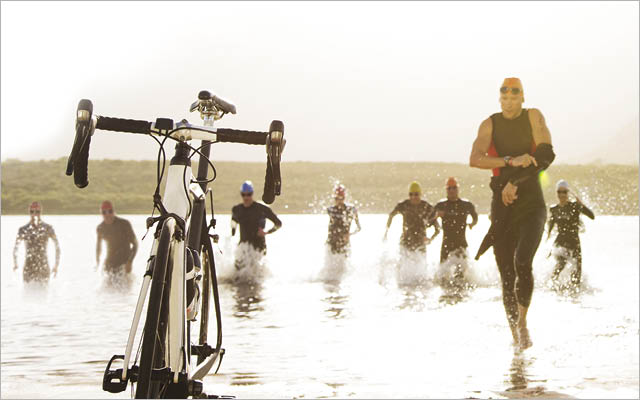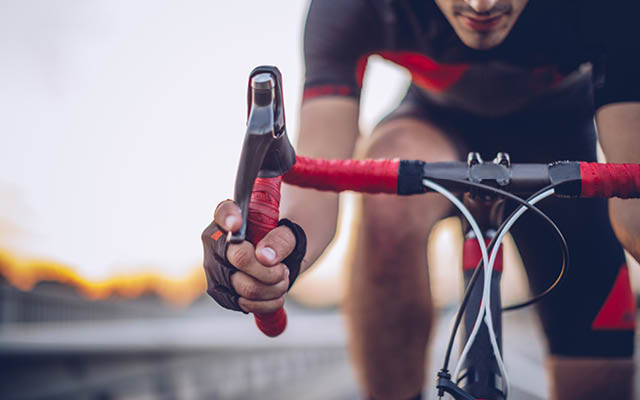Before the 2000 Olympics in Sydney, “triathlon” was a quirky sport reserved for the most maverick athletes. Many people had never heard of it. But when 111 million viewers tuned in and saw the event’s Olympic debut, featuring a one-mile swim, 25-mile bike ride, and six-mile run, they were hooked.
“The women’s race was the first event of those games and got tremendous coverage in the United States,” notes Joe Friel, MS, author of The Triathlete’s Training Bible. People were intrigued by the multisport and endurance aspects of triathlon. “It was to Americans what the marathon was in the 1980s.”
More than a decade later, the sport hasn’t lost its momentum. No one knows for certain how or where it began: Some say it started in San Diego in the 1970s; others believe it was born in France in the 1920s; and a third rumor holds that it began as a competition between lifeguards in Hawaii. Today, participation in triathlons is growing exponentially. An estimated 1.9 million people participated in at least one triathlon in 2012, the most recent year for which data is available, according to the Sports and Fitness Industry Association. And membership in USA Triathlon (USAT), the national governing body for the sport, quadrupled from 1999 to 2012.
Accessibility is fueling the surge. The number of U.S. races has almost tripled in the past seven years, according to USAT, with the greatest growth among sprint-distance triathlons. These sprint races, with their shorter legs — typically a half-mile swim, 12-mile bike ride, and three-mile run — are as alluring to beginners as they are to hard-charging athletes.
Managing three sports can be a challenge, of course, but the benefits are huge: Cross-training is one of the best ways to increase your overall fitness while preventing overuse injuries that come from focusing too much on a single sport. “Even if you never actually compete, there are numerous cardiovascular, muscular, and metabolic benefits that come about from training for multisport endurance events,” emphasizes Glenn Gaesser, MD, director of the Healthy Lifestyles Research Center and the exercise and wellness program at Arizona State University. Upsides include overcoming muscle imbalances (tight hamstrings and weak quads, for example), a reduced risk of cardiac disease, and increased overall muscle mass (which boosts metabolism).
Triathletes report experiencing lower stress, greater social camaraderie, as well as increased discipline and motivation, all of which significantly influence other areas of their lives.
Training is a valuable time “for shedding worries, clearing your mind, and eliminating heavy thoughts and moods,” says Mark Allen, a six-time world champion Ironman and coauthor of Fit Soul, Fit Body. Endurance exercise can have similar stress-busting effects as meditation, he says, “and doing it outside in nature gives you a double benefit.”
Training is part physical, part mental, and part logistics. To reap the most enjoyment and finish strong, you’ll have to build multisport endurance (physical), hone a race strategy (mental), and learn to manage gear, nutrition, and transitions (logistics). What follows is a 12-week training plan for a sprint-distance event. It’s also adaptable for Olympic-distance events. Good luck, and enjoy!
12 Week Triathlon Training Plan
Preparing for three sports in three months is a big commitment. To make the process feel more doable, Troy Jacobson, national director of endurance sports coaching and Tri Team at Life Time, helped develop this basic training plan for a sprint triathlon. It breaks up your workouts by activity — completing your swim before work and running in the evening, for example.
Strength training will help you improve overall fitness, prevent injury, and boost performance. (For more specific strength-training advice, see “Triathlon Strong in 6 Weeks“.)
“The training program assumes you have a solid base of fitness and works to improve your aerobic base and endurance,” Jacobson says. To optimize the efficiency of your workouts, use a heart-rate monitor to gauge your effort.
A qualified coach or personal trainer can help you determine your target pace and optimal heart-rate zones for each workout.
The basic training structure is the same if you’re a beginner or advanced; only the intensity is different. You might do more twice-daily and interval workouts, for example, if you’re advanced or if you’re training for Olympic distances.
Keep in mind, too, that periodic “bricks” — biking and then running in the same session — are essential to prepare your legs for the odd sensation of getting off the bike and immediately running. Biking and running use different neuromuscular patterns, and lactic acid can build up in your muscles during the bike ride, making the legs feel heavy and stiff.
Find additional training plans and connect with coaches at www.lifetimeendurance.com. And, as with any new training regimen, get the green light from your doctor before starting.
| WEEK | MON. | TUES. | WED. | THURS. | FRI. | SAT. | SUN. |
| Week 1 |
Rest day | Run 20–30 min., strength train |
Rest day | Bike 30–40 min. | Swim 30 min., strength train |
Bike 30–40 min. | Run 20–30 min. |
| Week 2 |
Rest day | Swim 30 min., strength train |
Rest day | Bike 30–40 min. | Run 20–30 min., strength train |
Bike 30–40 min., swim 30 |
Run 20–30 min. |
| Week 3 |
Rest day | Swim 30–40 min., strength train |
Rest day | Bike 30–40 min. | Swim 30–40 min., strength train |
Bike 40–50 min. | Run 20–30 min. |
| Week 4 | Rest day | Swim 30–40 min., run 20–30, strength train | Brick: bike 20–30 min. + run 10–20 min. | Bike 30–40 min. | Rest day | Bike 30–40 min., strength train |
Run 20–30 min., swim 30–40 |
| Week 5 |
Rest day | Swim 30–40 min., run 20–30, strength train | Brick: bike 20–30 min. + run 10–20 min. | Bike 30–40 min. | Rest day | Bike 50–60 min., strength train |
Run 30–40 min., swim 30–40 |
| Week 6 | Rest day | Swim 30–40 min., run 30–40, strength train | Brick: bike 30–40 min. + run 20–30 min. | Swim 30–40 min., bike 30–40 |
Rest day | Bike 50–60 min., strength train |
Run 30–40 min. |
| Week 7 |
Rest day | Swim 30–40 min., run 30–40, strength train | Brick: bike 40–50 min. + run 20–30 min. | Rest day | Swim 30–40 min., strength train |
Bike 60–70 min. | Run 50–60 min., swim 30–40 |
| Week 8 |
Rest day | Swim 30–40 min., run 30–40, strength train | Rest day | Swim 30–40 min., bike 40–50 |
Rest day | Race simulation! Swim, bike, and run race distance | Rest day |
| Week 9 |
Rest day | Swim 30–40 min., run 20–30, strength train | Brick: bike 50–60 min. + run 20 min. | Bike 50–60 min. | Run 20–30 min., strength train |
Swim 30–40 min., bike 60 |
Run 40–50 min. |
| Week 10 |
Rest day | Swim 30–40 min., run 30–40, strength train | Brick: bike 50–60 min. + run 30 min. | Swim 30–40 min., bike 40–50 |
Run 20–30 min., strength train |
Bike 60 min. | Run 40–50 min., swim 30–40 |
| Week 11 |
Rest day | Swim 30–40 min., run 30–40, strength train | Brick: bike 40 min. + run 20 min. |
Swim 30–40 min., bike 30–40 |
Rest day | Swim 30–40 min., bike 30–40 |
Run 20–30 min. |
| Week 12 |
Rest day | Swim 30–40 min., run 20, strength train | Brick optional: bike 30 min. + run 20 min. | Swim 30–40 min. | Rest day | Bike 10–15 min., run 10–15 |
Race day! |
Download the 12-Week Triathlon Training Plan.
Master Logistics
Knowing what to wear, how to set up your transition area, what (and when) to eat, and where to position yourself at the starting line can make all the difference on race day.
Some experienced triathletes offer their best, hard-won tips:
Use a Checklist: Make a list well in advance of race day and try to do as much as you can in the days before to simplify your race morning. We’ve offered a basic checklist (next page) to get you started.
Fuel Up: Most pro triathletes say they eat a bland, high-carbohydrate breakfast two to three hours before the race (bagel and peanut butter, oatmeal with nuts, bananas, and the like). After that, your nutrition plan will depend on the length of the race and caloric needs. But try to avoid overeating, a common mistake among beginners. During the race, “A good rule of thumb is to consume 200 to 300 calories per hour,” pro triathlete Ashley Clifford says. Electrolyte or sports drinks and energy gels are best during the race.
Get Fitted: Take the time to get your running shoes and your bike professionally fitted, says Life Time Tri Team Director Troy Jacobson. It’s a free service offered at most specialty running and bike shops, and not only does it prevent injury, but it makes a world of difference in how comfortable you’ll feel during the race.
Get water-ready: It’s best to wear a wetsuit if the water is less than 72 degrees F. “If the water drops below 60 degrees, I like to wear a neoprene hat under my swim cap,” adds Clifford. Also, remember that a triathlon wetsuit is different (thinner, easier to move in) than a diving or surfing suit. You can rent or demo a triathlon wetsuit before you invest. Ask local triathlon clubs or retailers.
Keep it Simple: “Simplicity in my transition area is one of the most important things to me,” says Natalie Stiffler, 27, a competitive triathlete with the Triathlon Club of San Diego. “Try to have the minimum number of items laid out on your towel so you can quickly grab what you need and go.” A unique, brightly colored towel helps, too, since you can quickly spot it as you enter the transition area.
Swim the Edge: Open water doesn’t provide points of reference or a wall to help you catch your breath. “Swim along shore or follow buoys to stay straight,” suggests Clifford. “I like to take six strokes and lift my head to sight the buoy or shore.” If you’re a beginner, find a place along the side of the start area. “The last thing you want to do is be caught in the middle at takeoff and need to fight your way through kicking bodies,” she says.
Suit Up: If you plan to do more than a few triathlons, consider investing in a triathlon suit. These one-piece wonders eliminate the need for clothing changes, saving you time and energy during transitions. Suits range in price from $75 to $200 and are available from specialty running stores or online at places like www.swimoutlet.com or www.trisports.com.
Lube Up: “Friction and rubbing suck, especially from a wetsuit,” says Ironman veteran Saveria Tilden of Pasadena, Calif. “Body Glide anti-chafe balm is great for easing your wetsuit on and off. Apply it liberally to your neck, wrists, and lower legs.”
Ease the Bike-to-Run Transition: To avoid your legs feeling like Jell-O, use the last few minutes of the bike portion to stretch them out. Get out of the saddle and stand on the pedals for a few rotations to stretch your calves, put the bike in a lower gear and spin your legs out to loosen your hamstrings, or do a couple of stretches in the transition area.
Perfect Your Running Form: Sloppy running can sap your energy and cause you to bonk at the end of the race, says Olympic triathlete Andy Potts. “The better your form, the longer you’ll be able to run.” On your practice runs, concentrate on proper form: Look ahead (not down at your feet), and keep your shoulders open and loose (not tight and raised toward your ears), your hands in a loose fist (not clenched), and hips aligned. Your stride should feel comfortable, with your feet pushing off the ground and landing beneath your body. If your lower leg extends in front of your body, your stride is too long.
Triathlon Race Day Checklist
SWIM
- Swim suit/wetsuit/triathlon suit
- Goggles
- Swim cap
- Race chip
- Sunscreen
- Body Glide (if using a wetsuit)
- Towel
BIKE
- Bike (in low gear for easy start)
- Helmet
- Race number
- Air pump
- Cycling shorts
- Jersey
- Bike shoes
- Water bottles
- Gloves
- Spare tires/tubes
- Bike tools
- Chain lubricant
- Energy bars or gels
RUN
- Running shoes
- Socks
- Singlet
- Race number
- Gear belt (to hold energy gels, water, etc.)
- Sunglasses or visor/cap
MISCELLANEOUS
- Wristwatch
- Heart-rate monitor
- First-aid kit
- Plastic bags for wet clothes
- Postrace change of clothing
- Duct tape
- Camera
- Lip balm
- Phone
- Music player
Download The Triathlon Race Day Checklist.
Pick the Right Race
Not all triathlons are created equal. Sarah Labowsky, event manager for the New York City Triathlon, offers these tips for vetting a race before you sign up:
- “Check out the course maps, and, if you can, drive them to get a feel for the course before you sign up,” Labowsky suggests.
- The event website should offer detailed information about aid stations, medical tents, and other support (like volunteers and traffic control) available along the course. Some races even have sports psychologists on hand to help with pre-race jitters.
- Ask organizers what sorts of contingency plans are in place for inclement weather, such as choppy water or high winds, for example.
- Is there a governing body sanctioning the race? Find out who oversees the logistics and safety of any event you participate in. World Triathlon Corporation, USA Triathlon, and International Triathlon Union are the three largest, most reputable organizations.
- Check out comments on the event’s social media pages. Says Labowsky: “People are always posting and chatting about their experience, good and bad.”
Triathlon Distances in Miles
| Swim | Bike | Run | |
| Sprint* | .5 | 12.4 | 3.1 |
| Olympic | .93 | 24.8 | 6.2 |
| Half Ironman | 1.2 | 56 | 13.1 |
| Ironman | 2.4 | 112 | 26.2 |
* Some sprint races may be shorter



This Post Has 0 Comments